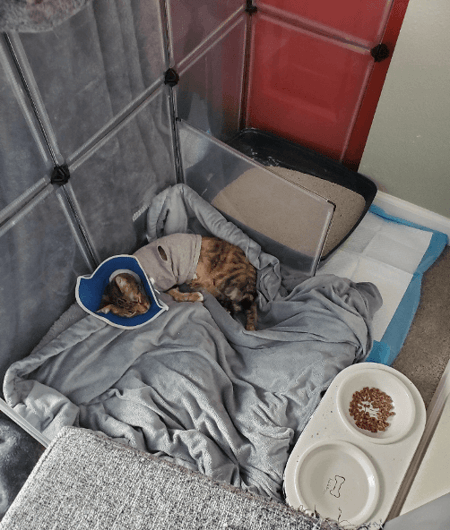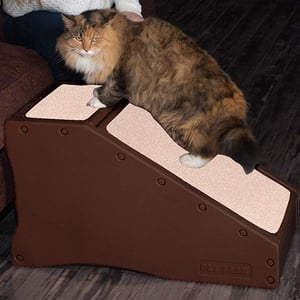
When discussing with my clients their cat’s surgical procedure, I often told them that the surgical part was easier than managing their aftercare.
Why?
There are several reasons – all connected to who cats are at their core.
1. Cats are naturally very athletic, even when they need to limit movement.
2. They're naturally resistant to things like taking medication or sitting still for a warm compress because those things don't feel particularly safe.
3. They are fastidious groomers, especially when they have a wound or creams and medications on their skin.
4. They're great at hiding pain and discomfort.
All of this makes those post-op instructions seem impossible. However, I'll try to take some of the pressure off with the following tips and tricks.
Regardless of the type of surgical procedure your cat has, it’s essential that they’re given the time, space, and environment to rest and heal.
Thankfully, the typical time necessary for post-op exercise restriction and/or confinement isn’t usually too long.
- Skin and soft-tissue surgical procedures (like a spay/neuter): usually ~10–14 days
- Orthopedic surgical procedures (involving bones or muscles): usually ~6–8 weeks
And while this may seem like an eternity, and there may be times when you’ll want to give up and let your cat get back to being a cat, I beg you to see it through. The complications that can arise after procedures, if you don’t properly limit your cat’s movement, can be far more time-consuming (and expensive) than the original surgical procedure — and they can sometimes even have catastrophic consequences.
Skip to section:
Potential Problems After Your Cat’s Surgery
Regardless of the surgery, you’ll need to keep your cat inside for their post-op recovery period. Even indoor cats need to avoid running and jumping in order to have a trouble-free recovery.
You must prevent your cat from climbing, running, and jumping during their post-op recovery phase because if you don’t, it could result in any of the following complications:
- Hitting something or falling in their disoriented state
- Breaking the sutures causing the wound to open
- Loosening their skin stitches or sutures, which will delay skin healing
- Loosening or causing failure of internal sutures or closures, which can cause bleeding or even leakage of bacteria or urine into the abdomen
- Pulling off bandages or even slipping bandages into a position that could cause more damage or pain
- A seroma (a collection of clear fluid under the skin at the surgical site) can develop, and if large, can be painful and can develop into an infection, and weaken the sutures
- Causing a bone plate, pin, or screw to move or otherwise not heal correctly
- Other problems
Best Places to Put a Cat After Surgery
If you opt to care for your cat at home after surgery, you should set up a comfortable post-op recovery space that will help control your cat’s physical activity.
Below are some suggested spaces, which will vary depending on your space, your cat, and the type of procedure they had.
The space should include their litter box, water, and food bowls, plus a comfortable bed or mat to lie on. Sometimes, the smaller the space, the better for restricting movement and promoting healing.
Large Carrier (Plastic Dog Crate)
Many people have good success using a large, plastic,  “airplane-style” dog crate for their cat’s post-op recovery space.
“airplane-style” dog crate for their cat’s post-op recovery space.
Honestly, they are likely my favorite way to contain a cat post-op.
These crates often have more than enough room for a bed where a cat can lounge and relax, but not get into too much trouble. A large enough crate should provide space for their litter box and food/water.
This PetMate Sky Kennel allows your cat ample room to recuperate and also doubles as a crate that can be used in the cargo area of an airplane. The 360-degree wire ventilation windows surrounding the kennel allow for better visibility and fresh air for your cat.
Portable Kitty Pen - Open Top
If your cat is young and can’t jump too high or throw a lot of weight around, a convertible option like the Songmics Pet Playpen may work well. It’s made of transparent plastic panels and simple plastic connectors, giving you the flexibility to create whatever style enclosure you need. It’s essentially a “build-your-own” option.

Songmics Pet Playpen
Buy on Amazon
You can combine panels to create high walls or stick with a single-panel shorter wall. The same panels can also be inserted as dividers within the enclosure if you want to keep food and water separate from the litter box or bed. Enclosure size is entirely up to you. You can build it with a floor if you need to protect your own floor. The possibilities are endless.
This is Bettina (photo above) during her recovery after a front leg amputation. One panel was used to separate her litter box from her resting area.
Bonus: These panels are easily disinfected.
Portable Kitty Pen With a Top
The ESK Collection Pet Exercise Pen is effective for cats that may attempt to climb or jump out, as it features a zippered top.
This enclosure provides enough room to take a few steps while still forcing your cat to rest. The space allows for a decent-sized litter box and food and water bowls that wouldn’t be constantly spilled.
For cats who prefer a daylight environment and the ability to see what is happening in the room, this pen provides that, plus plenty of fresh air. Mental healing is as important as physical healing.
Small Bathroom or Laundry Room
If a large kennel isn’t possible or practical, you can place your cat in a small bathroom or laundry room. However, there will likely be surfaces — anything from a windowsill or countertop, to a toilet or washing machine — that your cat may try to jump on.
And even that amount of jumping could pose risks, depending on the procedure your cat had. Plus, you’ll need to cat-proof the room — taking special care to remove or block access to trash cans, cabinets, medications, detergents, and other dangerous items. Check out our cat-proofing article for a more complete list.
 Bedroom
Bedroom
Similar to the bathroom or laundry room, a small bedroom might be a good option in certain situations. But also similar to a bathroom or laundry room, you’ll need to cat-proof the room and be aware of the potential for your cat jumping on the bed or another piece of furniture.
If moving the furniture out of the room isn’t practical, you may want to add pet stairs or a pet ramp next to the furniture so your cat can get up and down without having to jump. The Pet Gear stair and ramp combination (see inset photo) has carpet and a gentle slope, making it easier for your cat to get on the bed or couch.
Walk-In Closet
In certain situations, adapting your walk-in closet to a recovery room can be convenient. The area isn’t too large, and generally, there are not the same hazards that are present in bathrooms and bedrooms. However, be sure to remove items from the floor that your cat can climb on or knock over.
With Your Vet
In certain situations where you don’t feel comfortable with managing your cat’s care post-operative, or exercise restriction is extremely important, and proves too difficult in your home, ask your veterinarian or local veterinary ER if there are “medical boarding” options available. I had many clients choose this option. While it may seem to add cost, it’s likely to be far less money than you’d have to spend on complications due to incorrect exercise restriction. You'll want to consider your cat's mental well-being and manage it accordingly. Your veterinarian may recommend some calming aids or medications.Questions? If you would like to speak with a veterinarian about your cat's post-surgical recovery, Click here
How to Help Your Cat Survive ‘Crate Rest’
During the first 24 to 48 hours, as cats recover from anesthesia, they may lull you into a sense of confidence that they will remain calm and relaxed the whole time their activity is restricted. Unfortunately, that is unlikely to be the case. So, how do you help your cat adjust to their new confines?
Consider using calming aids to help relax them. Some options include:
- Calming pheromone diffusers or sprays
- Calming treats, such as VetriScience Composure treats, Solliquin, or Zylkene
- Calming supplements
- Calming music
Providing your cat with some extra love and attention, with gentle petting and speaking softly, can go a long way in comforting and keeping your cat settled.
Even though your cat can’t engage in physical activity, you can help satisfy their need to hunt and keep their brain active with mental enrichment. Such options include food puzzles or treat-dispensing toys. You can also try having a TV play calming pet-specific shows.
Select toys that don’t require a lot of movement to keep your cat engaged and rotate them every few days. These senior cat toys and activities are good options.
If your cat just won’t tolerate restricted activity, consult with your veterinarian about medications that they could prescribe to help keep your cat calm.

The Best Post-Op Litter
Your vet will give you detailed post-op instructions to follow about food, water, and your cat’s litter box needs based on the specific procedure your cat had.
Depending on the type of procedure your cat had, especially the presence of any skin stitches or bandages, it might be wise (and often recommended) to switch from your cat’s regular clay or other type of litter to one that’s less likely to get caught in their wounds and bandages.
Often, the best type of litter for a cat with skin sutures or bandages is a shredded or pelleted paper-based litter. You can usually shred regular printer paper in a paper shredder (but always remember to turn off the shredder or unplug it to avoid accidents), or tear up newspaper or paper towels to put in a litter box. I even had a client who ran a roll of toilet paper through a shredder and used that for litter.
Since none of these are particularly absorbent, it’s often a good idea to place an absorbent pee pad on the bottom of the litter box and then put the shredded paper litter over top.
Or, if you’d rather not deal with shredding paper yourself, try the pelleted recycled paper litter options, like Fresh News.
Nursing Care for Your Cat After Surgery
Your vet will give you detailed post-op instructions about the necessary “nursing care” your cat will need following their procedure and their post-op recovery phase. Here are some things you can expect to be part of the post-op care.
Rest
Your cat will be groggy until the anesthesia wears off. Let them rest in a quiet area as much as possible, but continue to check on them throughout the day to make sure they're comfortable and recovering normally (e.g., steadily getting their energy back and waking up from their sedative and anesthetic medications, no abnormal bleeding or swelling, regaining their appetite, etc.).
Medication
If your cat has gone home with any medications (or prescriptions for medications), it’s important to give them at the time and amount directed by your veterinarian, whether those medications are to help combat pain, infection, or anything else. If you have any problems giving the medications or any questions about giving them, check with your vet. But never stop giving medications early without first discussing with your veterinarian.
Need some tips on how to pill your cat? Also, check out the video below. Failure to stick with the advised medication schedule could result in avoidable pain for your cat, antibiotic-resistant bacterial infections, and other problems.
E-Collar/Cone
That dreaded “cone of shame” really is important. If your cat is allowed to lick or chew at the incision or surgical site, it could possibly open (dehiscence), heal more slowly, and become infected. Additionally, E-collars are essential if your pet has a drain at their surgical site. If a drain is pulled too soon, it can cause complications.
The E-collar helps prevent your cat from accidentally harming themselves, even though it’s inconvenient. Learn how to desensitize your cat to wearing an Elizabethan collar, as well as suggestions on alternative cones and post-surgery recovery suits.
NOTE: Even though your cat has a ‘cone’ on, other pets in the household don’t. DO NOT allow them to lick your cat’s surgical site. I have seen it happen, and the complications were significant.
Inspect the Incision
If your cat has an incision, check on it in the morning and again at night. It may be red and slightly swollen for the first day or so, but continued redness, bruising, swelling, or seepage should be cause for concern. Check with your vet if you think the incision isn’t healing properly.
In situations where the surgical site or injury can't be closed, be sure to follow your veterinarian's wound care instructions closely so that healing isn't delayed. You can read more here about wound care for cats and how to treat an injury.
Clean the Drains
Cat bite abscesses and some other surgeries may require the placement of surgical drains: small rubber tubes or pieces of surgical fabric that allow fluid to drain out. It’s important that you inspect and, if directed by your vet, clean the drains and surrounding areas regularly.
Keep Fur Clean
Follow-Up Check-Ins
Recheck vet visits are often necessary following surgical procedures. Sometimes it’s to remove drains and/or skin sutures or replace a bandage. Sometimes it’s to recheck blood tests, urine tests, or X-rays. Other times, it’s just to repeat a physical exam to make sure everything is healing properly. Either way, these recheck exams are important to your cat’s complete recovery and continued health. Don’t skip them without first checking with your vet.
Your Vet Is There to Help You and Your Cat
You and your cat will likely have gone through a lot with their surgery… both in terms of the costs and logistics for you, as well as the actual anesthesia and surgery for your cat. The way you care for and nurse your cat in their “post-op period” can have as big an impact on the success of their recovery as the skill of the surgeon who performed the procedure.
Want an idea of what to expect? Here is the experience one of our Preventive Vet team members had.
To help ensure the fastest, most complete, and least stressful recovery for your cat, please discuss their specific post-operative recovery instructions with your veterinary team and follow their instructions carefully.
If you have any questions or concerns at any point, your vet or their staff will be happy to help you. If necessary, your vet may even be able to provide you with certain medications to help reduce your cat’s “cabin fever” and make both of your lives that much easier.
When we vets say, “Don’t hesitate to call if you’ve got problems or concerns,” we really mean it. We’d rather help you with your questions and concerns early on than tend to avoidable post-op complications later. When in doubt… call.






